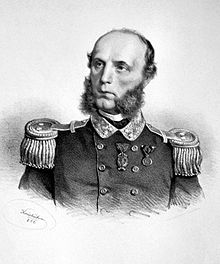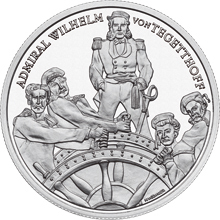Wilhelm von Tegetthoff
Wilhelm von Tegetthoff | |
|---|---|
 Wilhelm von Tegetthoff, litography byJoseph Kriehuber,1866 | |
| Born | 23 December 1827 Marburg,Duchy of Styria,Austrian Empire (now Maribor inSlovenia) |
| Died | 7 April 1871(aged 43) Vienna,Austria-Hungary (modernAustria) |
| Allegiance | |
| Service/ | |
| Years of service | 1840–1871 |
| Rank | Vice admiral |
| Battles/wars | |
Wilhelm von Tegetthoff(23 December 1827 – 7 April 1871) was anAustrianadmiral.He commanded the fleet of theNorth Seaduring theSecond Schleswig Warof 1864, and theAustro-Prussian Warof 1866. He is often considered by some Austrian historians to be one of the most adept naval officers of the 19th-century, due to his tactical inventiveness, sense of command, and inspirational leadership.[1][2]
Early life and career
[edit]Tegetthoff was born inMarburg,Duchy of Styriain theAustrian Empire(now Maribor,Slovenia), on 23 December 1827. He was the son of Karl von Tegetthoff, anOberstleutnantin the Austrian Army. On his mother's side he was related toJohann Kaspar Freiherr von Seiller,mayor of Vienna from 1851 to 1861. Entering theMarinecollegium(naval academy) inVenicein 1840, Tegetthoff became aSeekadetton 23 July 1845 and witnessed the Venetian uprising in 1848/49. He received a commission upon his graduation on 16 April 1849 and took part in the blockade of Venice from May to August 1849. Tegetthoff was promoted toFregattenleutnanton 16 June 1851 andLinienschiffsleutnanton 16 November 1852.[3]
Tegetthoff received his first command, the naval schoonerElisabeth,in 1854. This was at the time of the Austrian Navy's intensive conversion to steam power, of which he was an earnest advocate. In 1855 he was appointed commander of the paddle steamerTaurus,patrolling the Sulina mouth of the Danube during theCrimean War.This service brought him to the favorable notice ofArchduke Ferdinand Maximilianof Austria, theOberkommandant der Marine(High Commander of the Navy), with whom he had been acquainted since 1850. Promoted toKorvettenkapitänin 1857, Tegetthoff served on a semi-official scientific expedition to the Red Sea and to the island ofSocotra.[4]Having shown exceptional diplomatic and organizational ability, in December 1857 he was appointed astaff officer.He was named commander in 1858 of the new screwcorvetteErzherzog Friedrichon the coast ofMorocco,then in a confused state of disorder.[3]
The Italian campaign of 1859 saw the Austrians unable to challenge the French fleet for mastery of the Adriatic. With the return of peace, Tegetthoff accompanied Ferdinand Maximilian, who was to be the futureMaximilian I of Mexico,on a voyage toBrazilto visitEmperor Pedro IIduring the winter of 1859/60. PromotedFregattenkapitänon 27 April 1860 andLinienschiffskapitänon 23 November 1861, he was named commander of the Levant Squadron in 1862. In this capacity, he monitored the Greek revolution that deposed KingOtto Iand the anti-Western disturbances in Syria.[3]
Second Schleswig War
[edit]
During theSecond Schleswig War,Tegetthoff as aKommodorewas given command, in February 1864, of a small Austrian squadron that sailed to the North Sea to support the weaker Prussian naval forces against the superior Danish navy which was blockading northern German ports. He was engaged by a Danish squadron commanded byEdouard Suensonat theBattle of Heligoland,in which Tegetthoff's flagship, the screw frigateSchwarzenberg,caught fire in a close-range gunnery fight with the Danish frigatesNiels JuelandJylland.Although the action was a tactical defeat for Tegetthoff, he achieved his main objective since the Danish squadron was shortly thereafter recalled to Copenhagen, lifting the blockade of theElbeandWeserports. Tegetthoff's telegraphic dispatch was answered by EmperorFranz Josef Iwith another on 12 May 1864 promoting himKontreadmiral(Rear Admiral) and conferring upon him theOrder of the Iron Crown.
Seven Weeks' War
[edit]Tegetthoff was appointed commander of the Austrian battle fleet on 9 May 1866, shortly before theSeven Weeks' Waragainst Italy. Although the Italian fleet was larger and more powerful, Tegetthoff decided to engage it after a successful reconnaissance of the Italian base ofAnconaon 27 June 1866. With their army suffering defeats against the Austrians during the first week of the war from 20 to 27 June 1866, the Italians sought a victory over the Austrian navy by sending their fleet against the Austrian naval base atLissa,off the coast ofDalmatianear Spàlato (Split) on 16 July 1866. Encountering the Italian fleet early on the morning of 20 July 1866, Tegetthoff sailed straight for the center of the Italian fleet, hoping to ram the ships to make up for his own fleet's lack of firepower (Rammstoßtaktik). The smoke from the Italian ships made visibility very poor, however, and the Austrians missed the Italian fleet completely. Swinging around, Tegetthoff again charged, this time setting two Italian armored ships on fire and damaging several more.
After Tegetthoff's flagship, theErzherzog Ferdinand Max,rammed and sank the armored ItalianfrigateRe d'Italia,the Italian fleet retreated the next day. Tegetthoff returned in triumph to his base atPula.Nevertheless, his victory did not materially affect the outcome of the war, as Italy's alliance with Prussia ensured an advantageous peace due to Prussian victory in theAustro-Prussian War.Tegetthoff was immediately promoted, by telegraph, toVizeadmiral(Vice Admiral). He received congratulatory telegrams from Ferdinand Maximilian, by then the embattled Emperor of Mexico, andVizeadmiralHans Birch Dahlerup,formerOberkommandant der Marine(High Commandant of the Navy). Tegetthoff was decorated with theCommander's Cross of the Military Order of Maria Theresaand made honorary citizen ofVienna.
Following the victory of Lissa, Tegetthoff urged Franz Josef to annex the hinterland of the Dalmatian coast, so as to protect the region for development of naval bases. This was in fact accomplished with theoccupation(1878) andannexation(1908) ofBosnia and Herzegovina,though long after Tegetthoff's death.
Tegetthoff undertook a journey of study to France, Britain and the United States in 1866/67. Upon the execution ofFerdinand Maximilianby the Mexican government ofBenito Juárez,Tegetthoff was sent with the screw frigateNovarato bring his body home to Austria, arriving in the port of Trieste on 16 January 1868.
Late years
[edit]He received the post ofMarinekommandant,as the chief administrative officer was named in 1865 in succession of ViceadmiralLudwig von Fautz.In March 1868 Tegetthoff took also charge asChef der Marinesektion(Chief of the Naval Section) of the War Ministry of the newdual monarchy.Despite considerable resistance from the General Staff, he vigorously pursued a complete reform of theAustro-Hungarian Navy;his reforms remained in force until the fall of theDonaumonarchiein 1918.
On 1 April 1868 Tegetthoff was made aGeheimratand a member of theHerrenhaus. Tegetthoff died suddenly from pneumonia on 7 April 1871 inViennaat the age of 43. His grave is located in the cemetery of St. Leonhard inGraz.[5]
He was succeeded as head of the naval administration byFriedrich von Pöck.
Memorials
[edit]



Memorials to Tegetthoff were erected inMaribor,ViennaandPula.The monument on Vienna's Praterstern, the largest traffic junction of the city, consists of a column 11 meters high (byKarl Hasenauer), topped by a bronze statue of Tegetthoff, some 3.5 meters in height, byCarl Kundmannand was finished in 1886.[6]The memorial at Pula, also by Kundmann, was erected in 1877 and consists of a bronze statue of Tegetthoff, with supporting bronze mythological figures. Pula passed to Italian sovereignty in 1919, and in 1935 the monument was moved to Graz, Austria.
Tegetthoff was pictured on an Austrian postage stamp in 1935 and on a 20-euro coin minted in 2004 (see below). Ships named for Tegetthoff included:
- The arctic research ship SMSTegetthoff(1872).
- Thecentral battery shipSMSTegetthoff(1878)– renamed SMSMarsin 1912.
- The dreadnought battleshipSMSTegetthoff(1912).
Of these, the first was used in the 1872–74 arctic expedition ofJulius von PayerandKarl Weyprechtwhich discoveredFranz Josef Landin 1873. The expedition's first discovery was namedCape Tegetthoff.
See also
[edit]
- Wilhelm von Tegetthoff has left such a legacy behind that he was selected as a motive for a very recent commemorative coin: the 20 euroS.M.S.Erzherzog Ferdinand Maxminted on 15 September 2004. The reverse shows the Rear-Admiral after a painting byAnton Romako,standing on the bridge of the S.M.S.Erzherzog Ferdinand Max.In front of him four sailors are struggling with the wheel while bringing the ship into position.
- Austro-Hungarian Navy– the Navy following the 1867Ausgleich,which created theDual Monarchy
- SMSTegetthoff(1912)– Austro-Hungarian dreadnought battleship
- Battle of Lissafor at more detailed description of his most famous sea battle.
- Serbian word for ultramarin color is „teget “per Tegetthoff's surname (Serbian: Tegetof, Тегетоф), based on shade of his uniform.
References
[edit]- ^Antonio Schmidt-Brentano:Die K.K bzw. K.u.K Generalität 1816–1918Archived2013-10-04 at theWayback Machine.Österreichisches Staatsarchiv, Wien 2007, p. 185 (PDF).
- ^Antonio Schmidt-Brentano:Die österreichischen Admirale.Band I:1808–1895,Bibliotheksverlag, Osnabrück 1997, pp. 176–187.
- ^abcChisholm 1911.
- ^"Kolonialgeschichte: Tegetthoffs stümperhafte Geheimmission".12 June 2015.
- ^Manfred Jasser:Hoch vom Dachstein an. Das Steiermark-Brevier.Paul Neff Verlag,Wien 1990ISBN3-7014-0131-4S. 64. In 1871 One florin match in today's money about six euros.
- ^Felix Czeike:Historisches Lexikon Wien,volume 5, Kremayr & Scheriau, Vienna 1997,ISBN3-218-00547-7,p. 424
- Attribution
- This article incorporates text from a publication now in thepublic domain:Chisholm, Hugh,ed. (1911). "Tegetthoff, Wilhelm von".Encyclopædia Britannica.Vol. 26 (11th ed.). Cambridge University Press. pp. 504–505.
Literature
[edit]- German Wikipedia entry 'Wilhelm von Tegetthoff'de:Wilhelm von Tegetthoff
- Joan Haslip,The Crown of Mexico.New York: Holt, Rinehart and Winston, 1971.
- Alan Palmer,Twilight of the Habsburgs. The Life and Times of the Emperor Francis Joseph.New York: Grove Press, 1994.ISBN0-87113-665-1
- George Richard Marek,The Eagles Die. Franz Joseph, Elisabeth, and their Austria.New York: Harper & Row, 1974.
- Anthony Sokol,The Imperial and Royal Austro-Hungarian Navy.Annapolis: U.S. Naval Institute, 1968.
- Klaus Müller:Tegetthoffs Marsch in die Nordsee. Oeversee, Düppeler Schanzen, Helgoland im deutsch-dänischen Krieg,Verlag Styria, Graz 1991,ISBN3-222-12007-2
- Christian Ortner:Der Seekrieg in der Adria 1866,inViribus Unitis,Jahresbericht 2010 des Heeresgeschichtlichen Museums. Wien 2011, pp. 100–124,ISBN978-3-902551-19-1.
- Ulrich Schöndorfer:Wilhelm von Tegetthoff,Berglandverlag, Wien 1958.
- Peter Handel-Mazzetti, Hans Hugo Sokol:Wilhelm von Tegetthoff. Ein großer Österreicher,OÖ Landesverlag, Linz 1952.
- Kapitel 7:Wilhelm von Tegetthoff,inWilhelm Wolfslast:Helden der See. Band 1. Entdecker und Admirale,Berlin 1944, pp. 102–117.
- Helmut Neuhold:Österreichs Helden zur See.Styria Verlag Wien-Graz-Klagenfurt 2010, pp. 108–139.ISBN978-3-222-13306-0.
- Agnes Husslein(ed.):Anton Romako. Tegetthoff in der Seeschlacht bei Lissa.Katalog zur Ausstellung in derÖsterreichischen Galerie Belvedere,Wien 2010,ISBN978-3-901508-79-0.
- Pemsel, Helmut. "Wilhelm von Tegetthoff: Admiral of the Unexpected." InThe Great Admirals: Command at Sea, 1587–1945.Edited by Jack Sweetman. Annapolis: Naval Institute Press, 1997.ISBN0-87021-229-X.
External links
[edit]![]() Media related toBaron Wilhelm von Tegetthoffat Wikimedia Commons
Media related toBaron Wilhelm von Tegetthoffat Wikimedia Commons



